Minimum water exchange reduces shrimp Met requirement
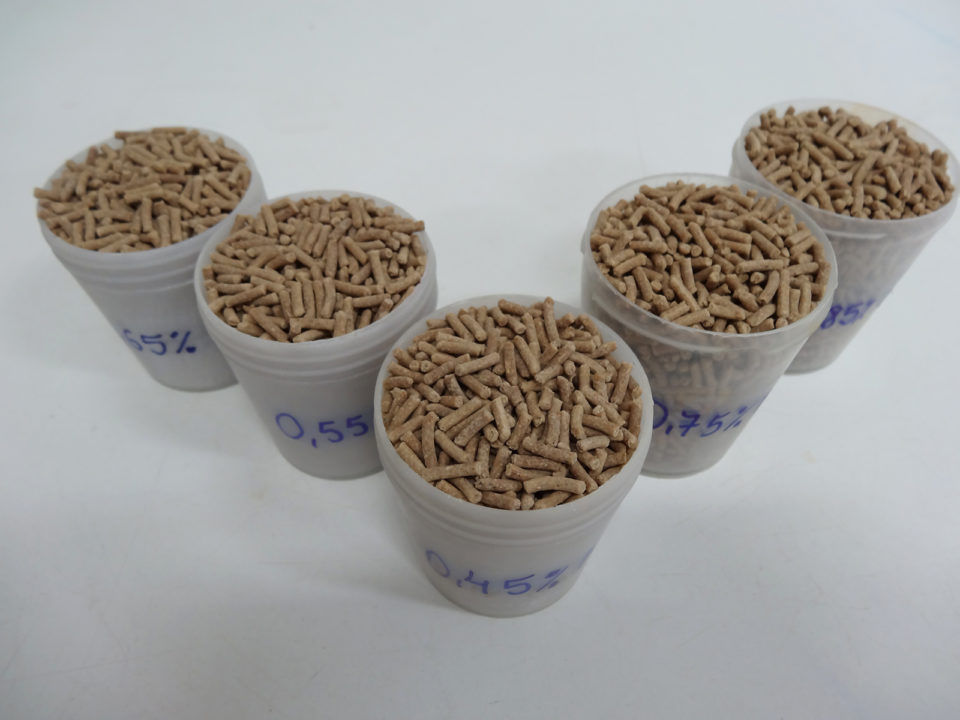
The amino acid requirements of marine shrimp have been established using flow-through, clear-water culture systems – to provide maximum control over the nutrient composition of experimental diets and avoid negative effects of metabolites, and to allow comparisons with results already published –using semi-purified or purified diets.
But these testing conditions may not be representative of specific, practical production situations where natural food or other pond production variables – stocking density, water quality and feed management – can potentially interfere with shrimp nutrition and animal growth performance. Very few studies have attempted to quantify the effects of these production variables on shrimp amino acid nutrition.
Previously we have demonstrated that the response of Pacific white shrimp (Litopenaeus vannamei) to dietary Met+Cys (methionine + cysteine) content closely relates to shrimp stocking density and natural food availability. In other production systems, like those with higher stocking densities or scarcer natural food, an increase of dietary Met+Cys in a total basis may be needed to support maximum growth of juvenile shrimp.
Pond water is exchanged in intensive production to reduce nitrogen load and toxic metabolites from uneaten feed, shrimp feces and dead algae. There has been a recent and growing trend to minimize pond water discharge, to increase biosecurity, promote more stable water quality conditions and reduce the risk of escapees. Primary pond productivity increases with water exchange reductions and can be a food source and positively contribute and support marine shrimp growth.
This article presents the results of a study we carried out to evaluate if reducing water exchange could spare dietary Met (Met+Cys) required for maximum growth performance of juvenile Pacific white shrimp (Litopenaeus vannamei) cultured in an intensive, outdoor culture system under 32.0 ± 3.7 g/L salinity. It is summarized from the original publication (Aquaculture Research 2018; 49:1682–1689.). The first author was supported by a scholarship under FUNCAP-CE (Fortaleza, CE, Brazil).
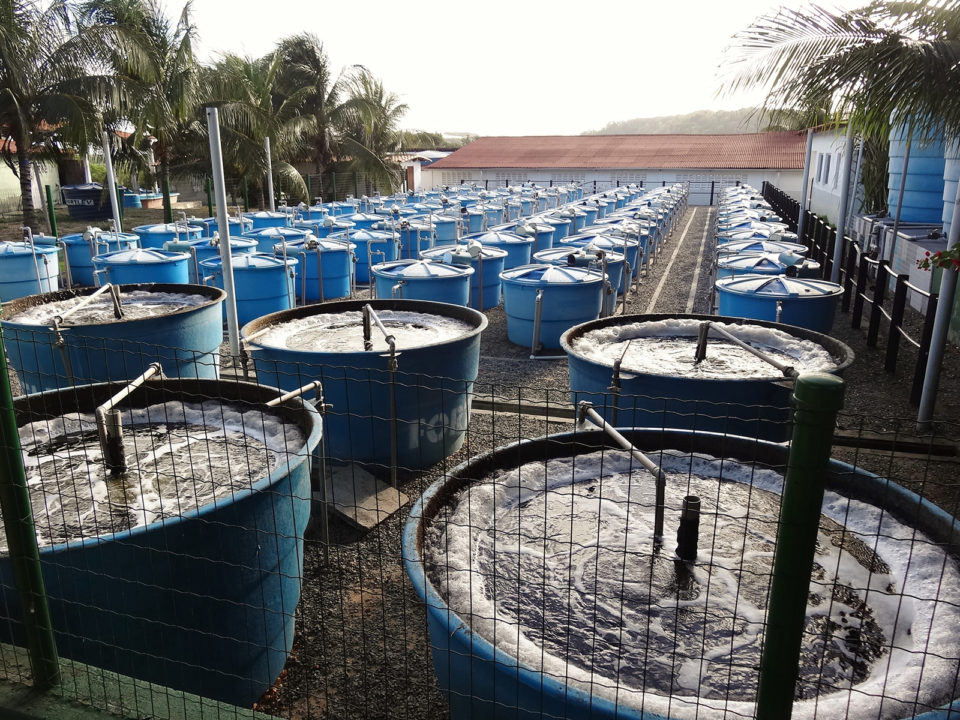
Study setup
Our study involved the evaluation of five diets formulated to include graded levels of dietary methionine (Met), from 5 to 9 g/kg (10 to 14 g/kg Met+Cys, respectively, in a dry matter basis, DM). Two water exchange regimes, flow-through (FL) and static (ST) water, were used to assess the diets.
Pacific white shrimp (L. vannamei) juveniles were reared in an outdoor green-water system (described by Façanha et al., 2016. Aquaculture, 463, 16-21). L. vannamei postlarvae (PL) were sourced from a commercial hatchery and were nursery-reared in the lab from PL10 to juvenile size. Shrimp of 1.98 ± 0.13 grams (mean ± standard deviation; n = 3,600, CV = 6.8 percent) were individually weighed for culling and stocked in outdoor, 1-cubic-meter tanks with a bottom surface area of 1.02 square meters. Five tanks were assigned to each treatment, totaling 50 tanks; shrimp were stocked at 70 animals per square meter (72 shrimp/tank) and cultured for 72 days.
The rearing system, water preparation and feed management were the same as described by Nunes et al. (2011. Aquaculture Nutrition, 17, 511-520) and Façanha et al. (2016). Initially, rearing tanks were filled with sand-filtered seawater at 35.0 ± 0.1 grams/L salinity and 7.95 ± 0.01 pH. Green-water conditions as described by Façanha et al. (2016) were reached regardless of the water exchange regime. No artificial fertilizers were applied. The static (ST) system operated by exchanging water at a daily rate of 1.4 percent to a maximum of 2.9 percent of total tank volume. Water exchange in the flow-through (FL) system was carried out at a rate of 100 mL/second (14.4 percent daily). Rearing tanks were provided with continuous aeration to reach near saturation of dissolved oxygen, and water quality parameters monitored daily in each tank.
The experimental diets were formulated with a minimum inclusion of fishmeal and other marine ingredients. To reach the targeted graded levels of dietary Met, a basal diet was first formulated to contain a minimum level of Met and only from intact sources. From this diet, four nearly similar diets were supplemented with a commercial dipeptide, DL-methionyl-DL-methionine. All diets were formulated on an ideal protein concept basis using lysine (Lys) as the first limiting and reference amino acid to maximize protein utilization, so diets were supplemented with commercial L-Lysine, L-Threonine and L-Arginine.
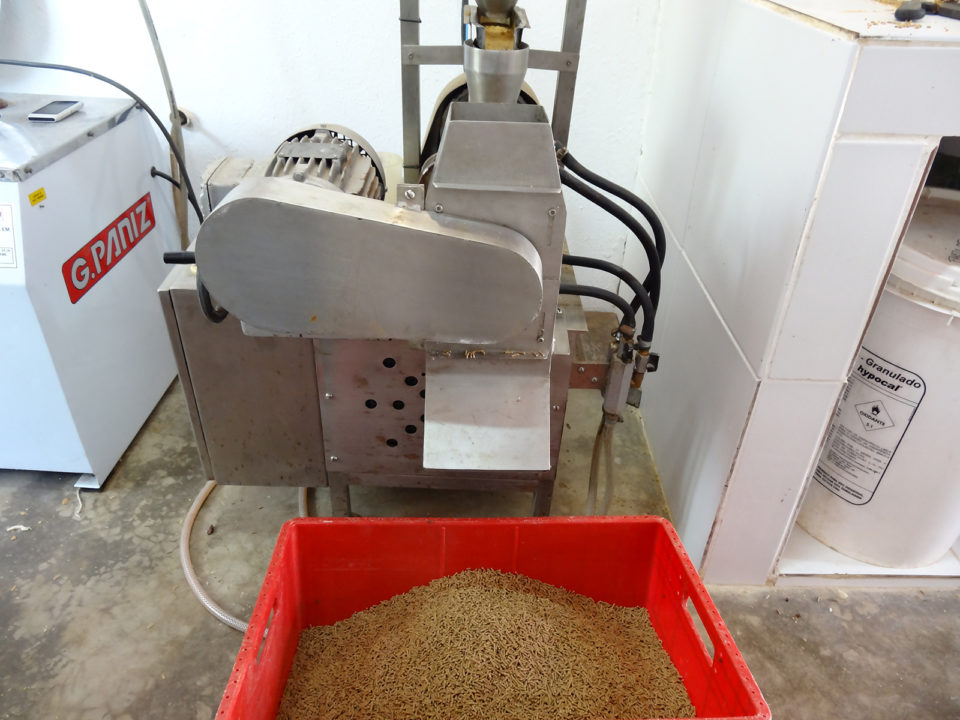
Diets were manufactured with laboratory equipment as described by Nunes, et al. (2011), with mean crude protein content of 361 ± 5.3 grams per kg. Total dietary Met reached 4.8, 6.2, 7.2, 8.1, and 9.4 grams per kg (DM basis) and subsequently Met+Cys at 9.6, 10.9, 11.9, 12.8, and 14.0 grams per kg, respectively. Shrimp were fed daily under a regular feed allowance using feeding trays, and feed rations were periodically adjusted.
For additional details on the experimental design, diets tested, shrimp and rearing conditions, growth performance and data analysis procedures, please refer to the original publication.
Results and discussion
Water quality parameters – temperature, salinity and pH – were relatively stable during the study, at 30.1 ± 1.7 degrees-C (n = 2,600), 32.0 ± 3.7 grams/L (n = 2,600), and 8.15 ± 0.22 (n = 2,600), respectively. The water exchange regime significantly influenced shrimp final survival, final body weight, gained yield, apparent feed intake (AFI), and FCR (Table 1, P < 0.05, ANOVA). Except for final survival and weekly growth rate, dietary Met content also statistically affected these variables.
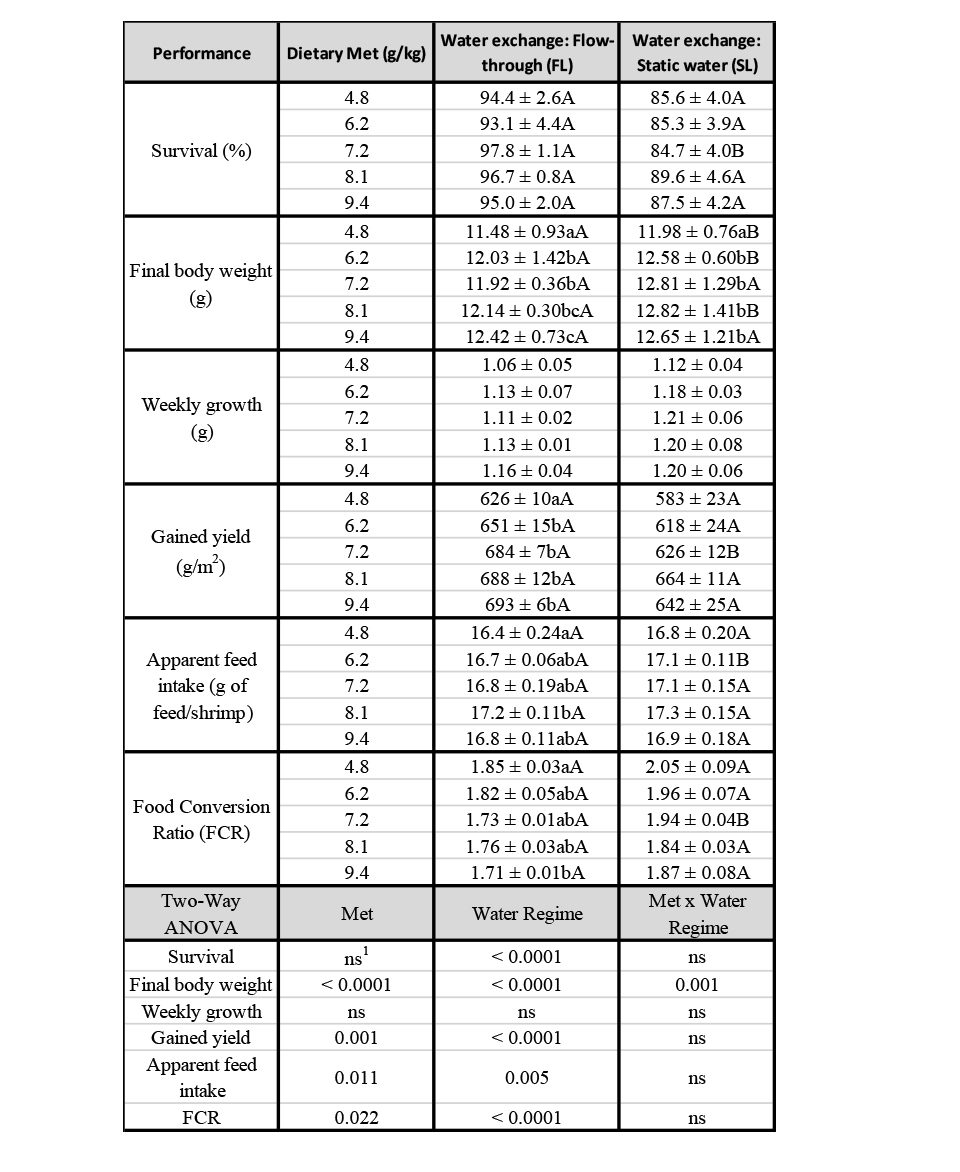
Shrimp survival was generally high with a mean (± standard deviation) of 95.4 ± 5.5 and 86.4 ± 8.4 percent in the flow-through (FL) and static (ST) water systems, respectively (P < 0.05). The FL system produced a higher gain in shrimp yield vs. the ST system, but only when shrimp were fed with 7.2 grams per kg dietary Met (P < 0.05). In the FL system, shrimp yield increased significantly with higher levels of dietary Met, up to 6.2 grams per kg (P < 0.05). No significant effect could be observed in the ST system regarding gained yield when dietary Met was increased from 4.8 to 9.4 grams per kg (P < 0.05).
AFI increased significantly in the FL system as dietary Met was increased from 4.8 to 8.1 grams per kg (P < 0.05). Shrimp grown in the FL system consumed less feed (16.8 ± 0.12 grams of feed/shrimp) than those reared in the ST system (17.1 ± 0.36 grams of feed/shrimp), mostly when fed 6.2 grams per kg Met). There was a statistically lower FCR in the FL system (1.73 ± 0.01) vs. the ST system (1.94 ± 0.04) with 7.2 grams per kg dietary Met. When dietary Met was increased from 4.8 to 9.4 grams per kg in the FL system, there was a significant reduction in FCR. In the ST system, no effect on FCR could be observed resulting from graded levels of dietary Met.
At harvest, final shrimp body weight (BW, grams) exceeded 11.5 grams. Water exchange regime and dietary Met content had a combined effect over final shrimp BW. There was a Met dose-response effect on final shrimp BW in the FL system. It increased gradually when shrimp were fed from 4.8 to 6.2 grams per kg Met, and then significantly increased with 8.1 grams per kg dietary Met.
There was a significant interaction between dietary Met level and water exchange regime for shrimp BW. BW under the FL system had a linear response to increasing doses of dietary Met and Met+Cys. The maximum shrimp BW resulted from dietary Met and Met+Cys levels of 9.4 and 14.0 grams per kg (on a dry matter basis), respectively. In the ST system, final BW increased from 4.8 to 6.2 grams per kg dietary Met and then stayed consistent along higher doses. Under the ST system, maximum BW in response to dietary Met and Met+Cys occurred at 8.0 grams per kg and 12.6 grams per kg of the diet (as a dry matter basis), respectively.
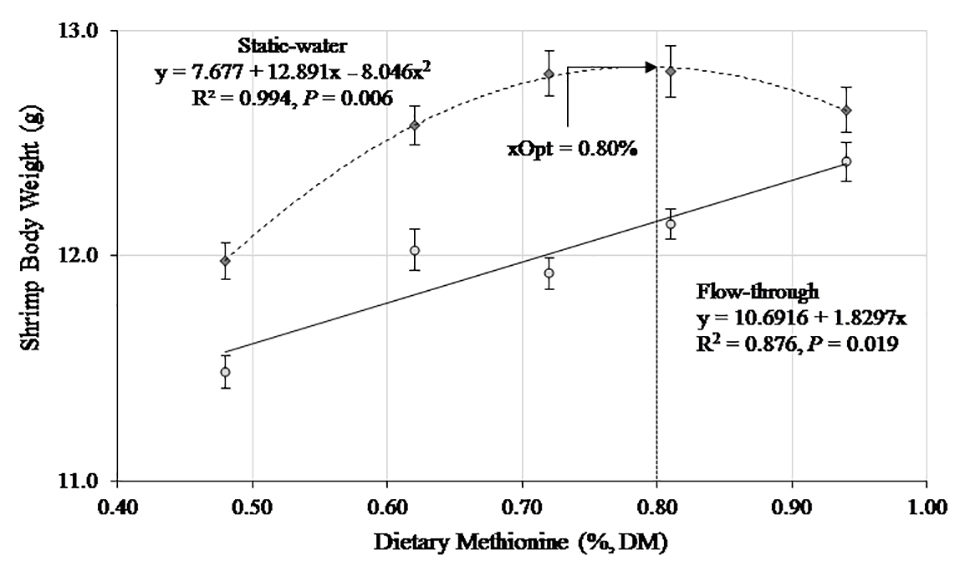
Results of our study showed that supplementation of DL-methionyl-DL-methionine (DL-Met-Met) at any level in diets containing 50 grams per kg of salmon by-product meal and about 348 grams per kg of soybean meal and with a total Met content of 4.8 grams per kg produced no performance improvement when the shrimp were cultured under a ST water exchange regime. But there was an increasing effect in shrimp final weight in the ST water system when DL-Met-Met was supplemented at 1.1 grams per kg, resulting in a diet with 6.2 grams per kg dietary Met (DM basis). Over this level, DL-Met-Met supplementation was not necessary in this water regime.
In the FL system, where natural food possibly had less availability, supplementation of DL-Met-Met at 1.1 grams per kg effectively supported a larger shrimp yield, feed intake, a reduced FCR and a larger final body weight. An additional improvement occurred in shrimp final body weight when DL-Met-Met was supplemented at 3.1 grams per kg, resulting in a diet with 8.1 grams per kg of total Met.
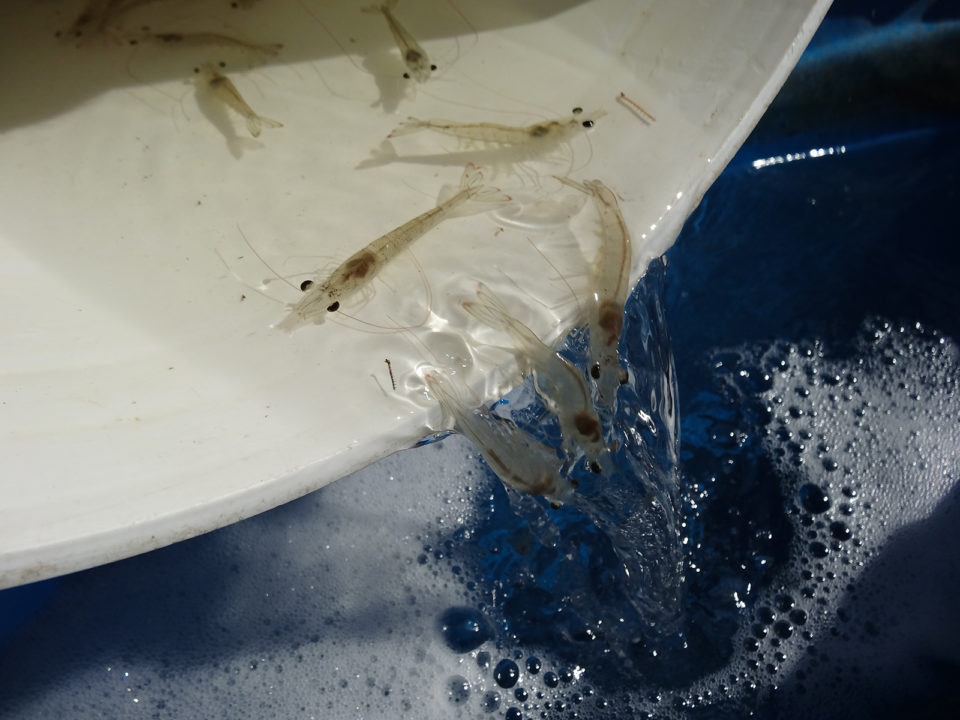
Perspectives
The results of our study, conducted under intensive outdoor conditions, show the ability of juveniles of Pacific white shrimp to utilize crystalline dipeptide forms of methionine. Results also show an interaction between dietary Met content and water exchange regime.
In our study, growing shrimp under limited – that is, static vs. flow-through water exchange regime – spared the dependence on higher levels of dietary Met to maximize the growth of Pacific white shrimp, from 9.4 grams per kg to 8.0 grams per kg (14.0 and 12.6 g/kg Met+Cys, respectively). A lower water exchange is desirable in intensive culture systems stocked under 70 shrimp per square meter, because it reduces the need for supplemental dietary Met.
Authors
-
Felipe Nobre Façanha, M.Sc.
LABOMAR – Instituto de Ciências do Mar
Universidade Federal do Ceará
Avenida da Abolição, 3207 – Meireles, Fortaleza, Ceará, 60.165-081, Brazil -
Hassan Sabry-Neto
LABOMAR – Instituto de Ciências do Mar
Universidade Federal do Ceará
Avenida da Abolição, 3207 – Meireles, Fortaleza, Ceará, 60.165-081, Brazil -
Dr. Claudia Figueiredo-Silva
Evonik Nutrition & Care GmbH.
NC, 10-B531, Postfach 1345
Rodenbacher Chausse 4, 63404, Hanau, Germany -
Dr. Adhemar Rodrigues Oliveira-Neto
Evonik Degussa Ltda.
Alameda Campinas, 579 - 10º andar.
São Paulo, São Paulo, 01.404-000, Brazil -
Alberto Jorge Pinto Nunes, Ph.D.
Corresponding author
LABOMAR – Instituto de Ciências do Mar
Universidade Federal do Ceará
Avenida da Abolição, 3207 – Meireles, Fortaleza, Ceará, 60.165-081, Brazil
Tagged With
Related Posts
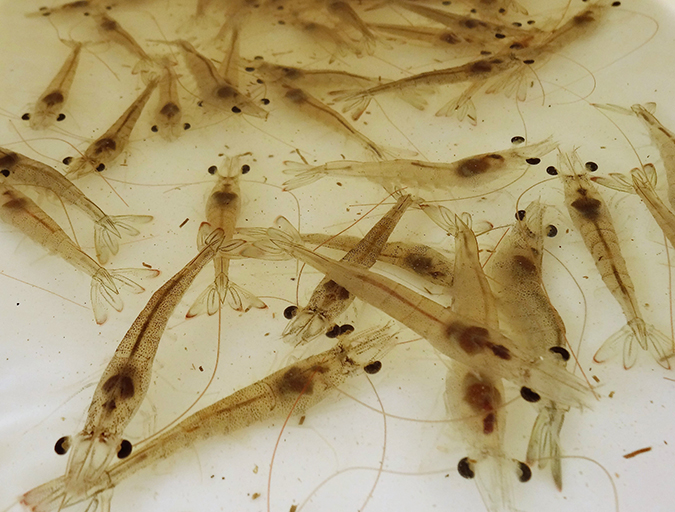
Health & Welfare
Effect of dietary methionine on Pacific white shrimp juveniles
This study tested five diets formulated with increasing levels of methionine (Met) and Met + cysteine (Cys) and their effect on growth performance of juvenile Pacific white shrimp stocked at 50, 75 or 100 animals/m2 in a green water system.
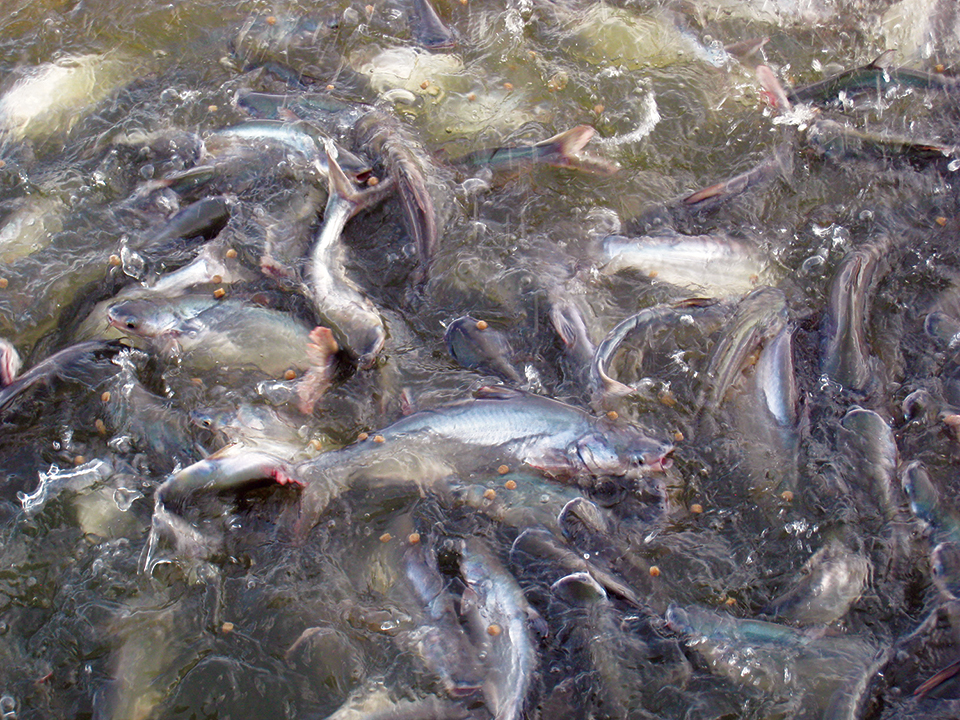
Health & Welfare
Amino acid supplementation reduces protein levels in pangasius diets
Trials show that supplementation with amino acids could reduce protein levels from a typical 28 percent to 23 percent in pangasius diets.
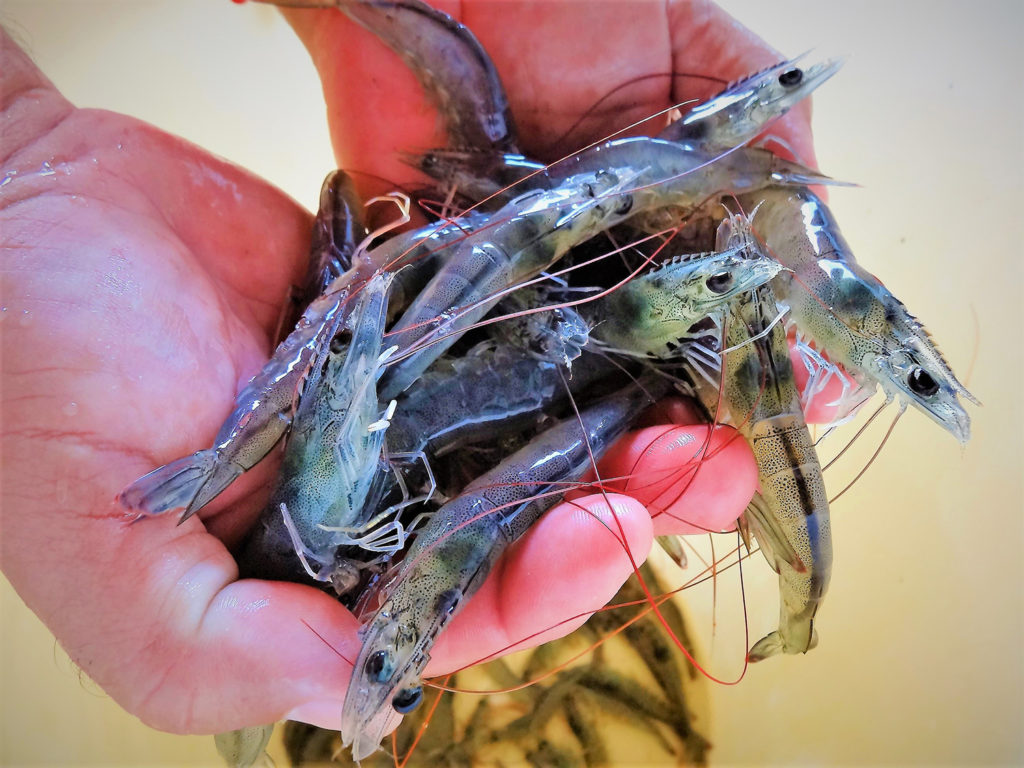
Aquafeeds
Krill meal performs well in shrimp feed experiments
A study of experimental diets for juvenile shrimp showed a halving of fishmeal usage. Limited inclusion of krill meal offset other expensive ingredients.
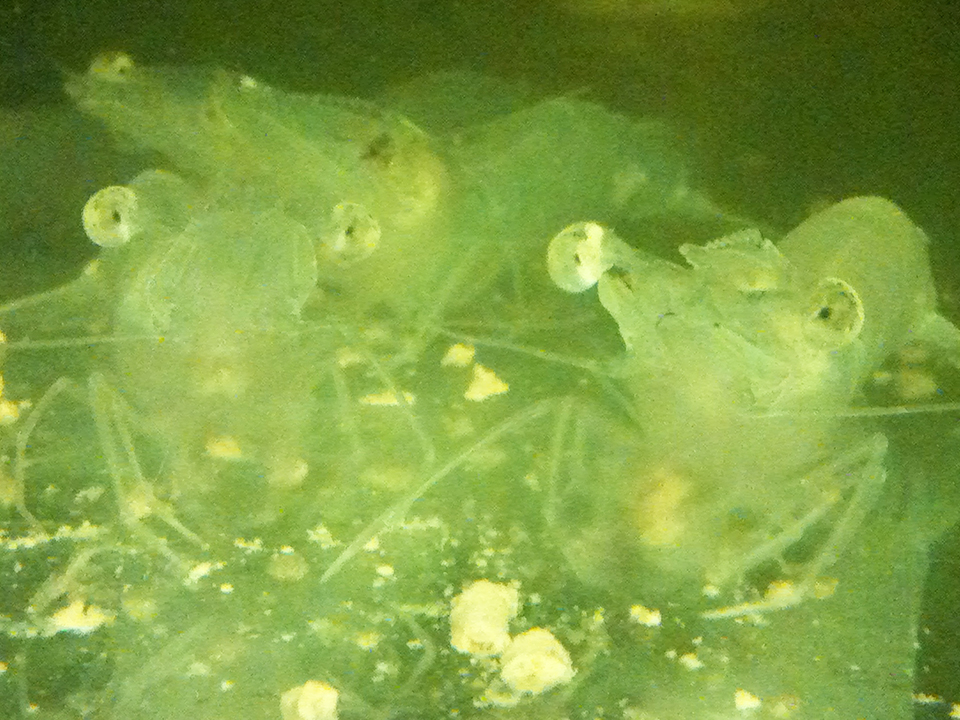
Aquafeeds
Soybean meal, distillers grains replace fishmeal in experimental shrimp diets
A study that used DDGS to partially replace soybean meal as the primary protein source in diets for juvenile white shrimp found the growth of shrimp significantly decreased when DDGS replaced soybean meal.


